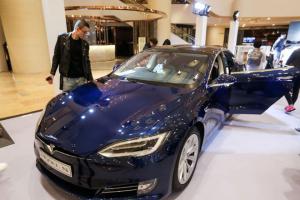A group of hackers in China have found a very simple way to fool Tesla cars: with carefully placed road stickers, they lure the Tesla Model S into the wrong lane. The above method is carried out by Keen Lab, one of the leading technology security research groups in the world.
Not only one, but they also discovered two ways to attack the lane recognition system of the Tesla self-driving system.
First, they tried to change the markings on the road surface, by putting more stickers on the lane line to make it blurred in front of the recognition camera. Experiments prove this method works, but according to security researchers, sticking paper on the lane line is very revealing, not to mention a clear illegal act.
So the researchers created “fake lanes”. They discovered that Tesla’s autopilot system would detect the lane if it noticed three small stickers deliberately placed on the road surface.
When they placed stickers at an intersection, they predicted the Tesla would mistake the stickers as a sign that it was still on the right track. On the test track, Tesla’s self-driving system went the wrong way, just as the security researchers expected.

Keen Lab’s method of fooling Tesla cars.
“Our experiments demonstrate the system’s vulnerability and show that reverse lane recognition is one of the most important elements of self-driving systems,” the Keen Lab research report states.
“In the test we set up, if the car knows the lane it is on will lead to a one-way street, it will know this is a fake lane to not enter, avoiding an accident.”
Keen Lab also claims to be able to remotely control Tesla cars and start wipers. According to what they say:
“In order to gain control of the steering wheel, security researchers have to go through a series of complex steps to penetrate the system. It is worth noting that when hacking the system, they are sitting right in the car; on the side of the vehicle. Besides, the hack cannot be successful when the car starts to run at a speed of over 8 km/h.However, when the vehicle is on Cruise Control mode, the hack takes place “without obstacles”.
To gain control of … the wipers, the researchers seem to have worked even harder: They had to trick the Tesla into believing it was raining. It’s easy to get a fake lane to go wrong, but according to Keen Lab, changing sunshine into rain is a bit difficult.”
This isn’t the first time Keen Lab has found problems with Tesla’s security system. Back in 2016, they once figured out how to hijack the brake system.
Last March, at the CanSecWest security fair, there was a Tesla car hack challenge with a prize of up to $ 900,000. Only one team found the loophole: two security researchers, Richard Zhu and Amat Cama, hacked the car’s browser, making it display the content they wanted.
The two hackers left with ,000 in their pocket and a Tesla.
You can watch a video of the entire hacking process here.

